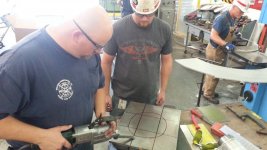Richard King
Diamond
- Joined
- Jul 12, 2005
- Location
- Cottage Grove, MN 55016
I thought I would help Douglas (dsymes ) out here and restart his thread as his was closed. He is new and didn't understand the rules of putting the Subject in the Title.
http://www.practicalmachinist.com/v...ing-scraping-inspection/some-like-hot-305527/
Here is his question to me.
dsymes --Plastic --Join Date
Aug 2010 ---Location -- WA, USA
In his recent thread, "Teaching a Class in Oregon", Richard mentioned "working 10 hour days in the maintenance shop in the heat (90 to 107, so far)". While my first reaction was to wipe my brow in sympathy, it also occurred to me that the granite surface plates, straight edges, iron surface plates (Richards photos show one such plate being scraped), and other work being scraped were cycling from moderate temperatures at night and the early morning to quite warm in the afternoon.
So... I'm hoping that Richard and others can comment on what effect this kind of temperature change during the course of a day has on the percision of (1) a typical grade "A" or "AA" granite surface plate's surface, (2) iron reference tools such as a three or four foot iron straight edge, and (3) precision scraped surfaces, such as being able to achieve 0.0002/foot flattness and 40ppi.
Douglas
http://www.practicalmachinist.com/v...ing-scraping-inspection/some-like-hot-305527/
Here is his question to me.
dsymes --Plastic --Join Date
Aug 2010 ---Location -- WA, USA
In his recent thread, "Teaching a Class in Oregon", Richard mentioned "working 10 hour days in the maintenance shop in the heat (90 to 107, so far)". While my first reaction was to wipe my brow in sympathy, it also occurred to me that the granite surface plates, straight edges, iron surface plates (Richards photos show one such plate being scraped), and other work being scraped were cycling from moderate temperatures at night and the early morning to quite warm in the afternoon.
So... I'm hoping that Richard and others can comment on what effect this kind of temperature change during the course of a day has on the percision of (1) a typical grade "A" or "AA" granite surface plate's surface, (2) iron reference tools such as a three or four foot iron straight edge, and (3) precision scraped surfaces, such as being able to achieve 0.0002/foot flattness and 40ppi.
Douglas





